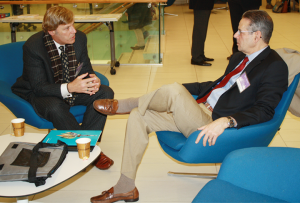
I attended the third annual North American Saliva Symposium (NASS) this year which was held at New York University College of Dentistry, December 9-10. It was an event filled with globally recognized researchers in salivary diagnostics presenting updates on their respective research efforts. The following is a glance into what the future holds for salivary diagnostics as well as the exciting application of salivary tests currently available.
Dental innovations of the future were captured by many of the researchers, but two that particularly caught my attention were Dr. John T. McDevitt and Dr. David Wong. Dr. McDevitt is a pioneer in the development of “lab on a chip” technology which will be capable of detecting biomarkers for diseases, such as cancer and cardiovascular disease. Dr. McDevitt predicts that in the near future individuals will provide a salivary sample, and have a diagnosis in about 15 minutes. Dr. David Wong focused on the use of saliva as a liquid biopsy and enthusiastically reported on the progress he and his UCLA team have made in the development of a point-of-care sensor that will have the ability to detect multiple markers in saliva for disease detection.
Highlights on laboratory services and testing available today were shared by my esteemed colleague Dr. Ron McGlennen. Ron brought to the group the understanding of laboratory specifics in regard to the day-to-day running of a medical laboratory, the clinical relevance of salivary diagnostic technology and the efforts to facilitate wider utilization of this technology among dental professionals. It was great to hear about the cutting edge lab tests that are available for healthcare providers today. There is certainly a balance to being a full-service laboratory, from daily lab activities, such as the influx of samples and generating test reports, to insightful conversations with providers to establishing salivary testing as the current leading opportunity for disease detection.
I was honored to present on the role of salivary diagnostics in the dental practice. Specifically, I shared the 3 primary roles salivary bacterial DNA identification has in my office. These include patients with periodontitis and individuals with a health or family history of cardiovascular disease, atherosclerosis and rheumatoid arthritis, among others. I also introduced the role of salivary technology as a periodontitis risk assessment and prevention tool. I stressed the importance of considering the species of bacteria revealed by saliva DNA tests and determining the likelihood of periodontal disease development.
The next North American Saliva Symposium, 2017 will be held in Vancouver, Washington. If you would like to know the technology that is going to change dentistry, medicine and all aspects of healthcare, plan on being there. It is among the most enlightening meetings you will ever attend.
For more information on how to become an OralDNA Provider – scan HERE: 
- The Insights Provided by Salivary Testing - December 27, 2019
- I Don’t Need That, We’re Already Getting Good Results - November 29, 2019
- What’s Your Excuse? - August 30, 2019
